Snapshot UI
The Snapshot User Interface (UI) provides immediate value to organizations as it does not require an API integration with Particle to access patients’ clinical data. The UI may be used by clinicians, clinical care coordinators, or any user involved in facilitating patient onboarding.
Accessing Snapshot patient data in the UI
Reach out to your Particle Health representative to get users at your organization provisioned for access to the Snapshot UI. Once users are provided access, they will be able to login and view your patients’ data.
User Login
Each user at an organization will be provisioned with their own user account to log in and view their organization’s patient data. Your Particle Health representative will notify you once your users have been granted access.
Once access has been granted to a user, that user will need to navigate to https://patients.particlehealth.com/login and reset their temporary password. To do so, navigate to the above login page and click on Need a new password?. Fill out the email address and select Send Email. If Particle finds the provided email address in the Particle records, an email will be sent to the user. Once the user receives an email link to reset the password, select the Reset Password link and follow the prompts. The user will receive a confirmation screen that the password was successfully reset.
The user can then navigate back to the login page https://patients.particlehealth.com/login and provide the updated login credentials. Upon first login, each user will be required to set up their MFA (multi-factor authentication) following the provided prompts. MFA will be a requirement for each subsequent user login.
Using the Snapshot UI
Find a patient
Patient Search
Upon logging into the UI, you will be navigated to the Patient Search page. Patient Search allows for searching of a specific patient by First Name, Last Name, and / or Date of Birth. When a specific patient's data needs to be found and viewed, this is the most efficient way to do so!
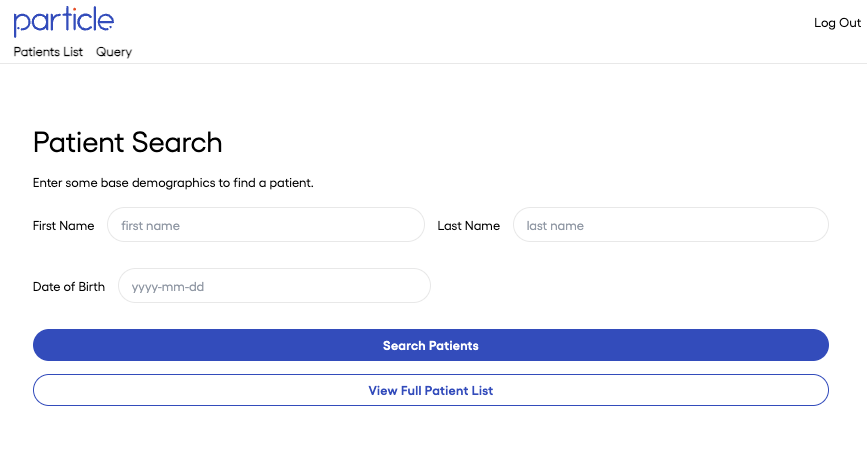
Patient List
Conversely, you may navigate to the Patient List page that displays a list of recently queried patients, with the most recent queries at the top of the list. It includes a patient’s demographics and query related metadata.
Queries that have been completed and those for which data was found are marked as ‘COMPLETE’. Queries that completed and those for which there was no data found are marked as ‘NO DATA FOUND’. This includes both scenarios where a patient was not found and where a patient was found but no data for that patient was available. Queries that have yet to complete running are marked as ‘RUNNING’. Note that Particle provides the expected query completion time for queries that are in the 'RUNNING' state.
The search bar can be used to search for a specific patient. To view a specific patient’s data, click on View.

Query a patient
Initiate a query
The Query page is used to initiate a new query for a patient. Required fields are indicated to run the query. Once the query is initiated by clicking the Query Patient button, the user is kicked back to the Patients List page where they can see the status of that initiated query. Once the query is complete, the status will display as ‘COMPLETE’ and the data will be accessible by clicking the View button.

Re-query a patient
Treatment use cases that necessitate pulling updates of a patient's data on a frequent and varying frequency can be easily facilitated via the 're-query' capability in the UI. This capability is intended to improve efficiency for users by not requiring they input the exact same patient demographics over-and-over again.

Response time
Once a query is initiated for a patient, Particle begins compiling that patient's data. During this process the query status will display as 'RUNNING'. We query the networks for documents, process the data (transform, deduplicate, normalize it, etc.), then push it into the UI for the user to interact with it.
The time needed to go through these steps this may vary depending on the number of documents that Particle obtains and the magnitude of content within those documents. Given this, it is normal for queries to take several minutes to display data in the UI post a patient being queried.
Particle will display the estimated query finish and the total file count that is being processed (for each query) to give visibility when a particular query is expected to complete given the variables that impact the query completion time.
Review a patient's data
Patient Overview
Once a patient’s data has been selected to View, the Patient Overview screen will display and provide basic clinical context for a patient.
Summary displays a patient’s demographics. Conditions display a patient’s coded diagnoses and problems, including both the description and clinical code. Medications display a patient’s current medications, including dosage, route, and status. Record Sources displays the list of facilities from which a patient’s data was pulled.
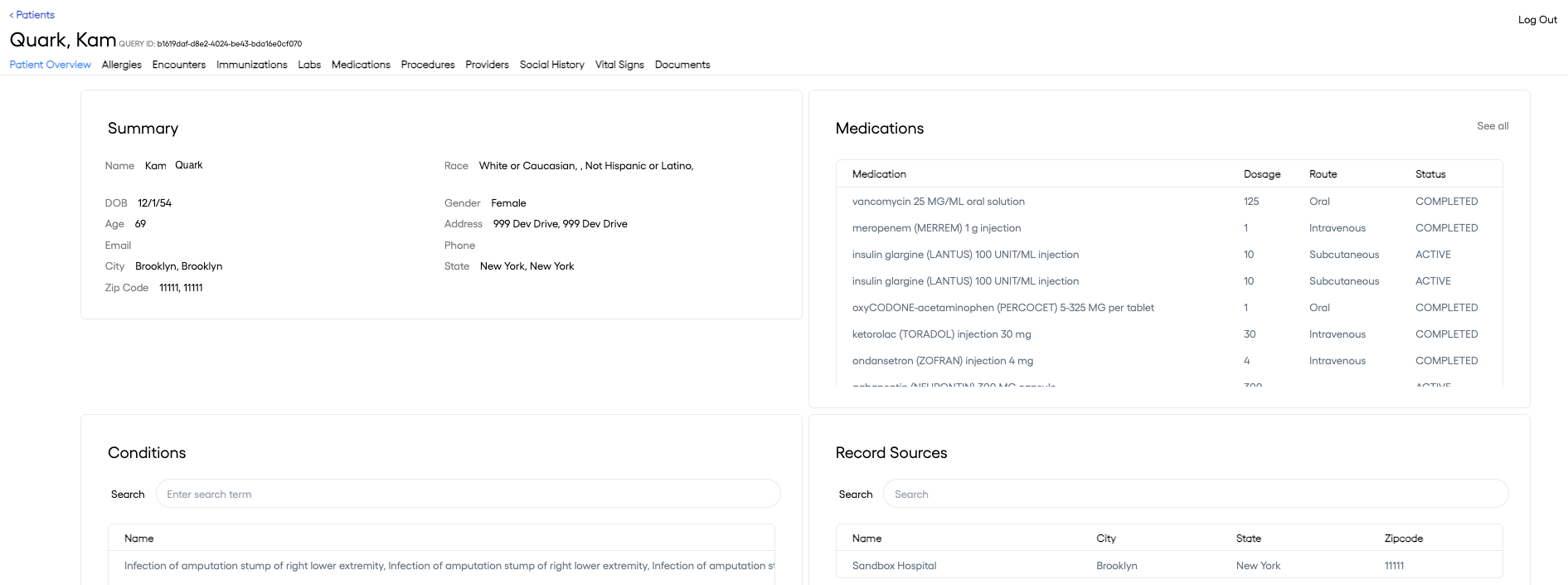
Allergies
Allergies page shows the patient's active and inactive allergies, including the associated reaction(s) of those allergies. Use the search bar or filters to find specific data you might be looking for.
Encounters
Encounters displays a list of all encounters recorded for a patient. The search bar can be used to search across any of the data e.g. a specific encounter type, ‘Emergency’ and see a list of all those encounter types to further understand how to proceed with treatment. Click on Show Notes to display the unstructured clinical notes written by a provider during the encounter.
The search bar can also be used to search across all clinical notes to find specific text within them. To initiate the search, type in the search term in the search bar, e.g. ‘abnormal’. Clinical notes containing that text are then filtered in the tabular view. Navigate across clinical notes to review the content with that search term included.
This search capability across clinical notes is also enabled for the Procedures page and clinical notes associated with each procedure.
Use the checkbox in the upper right-hand corner to toggle seeing encounters with incomplete records. By default, Particle will not show a record if any two of the following data elements are missing:start date, facility name or facility address, and clinical notes. But, if there are only notes available, particle will (by default) display that record.
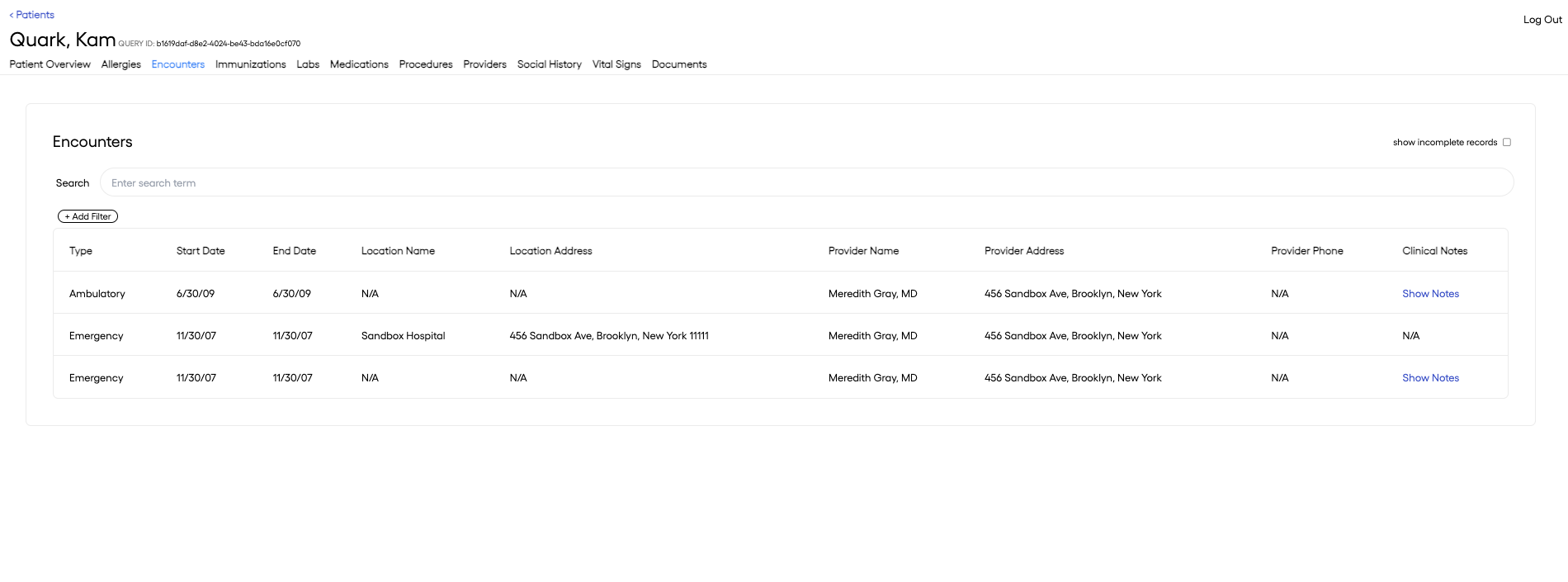
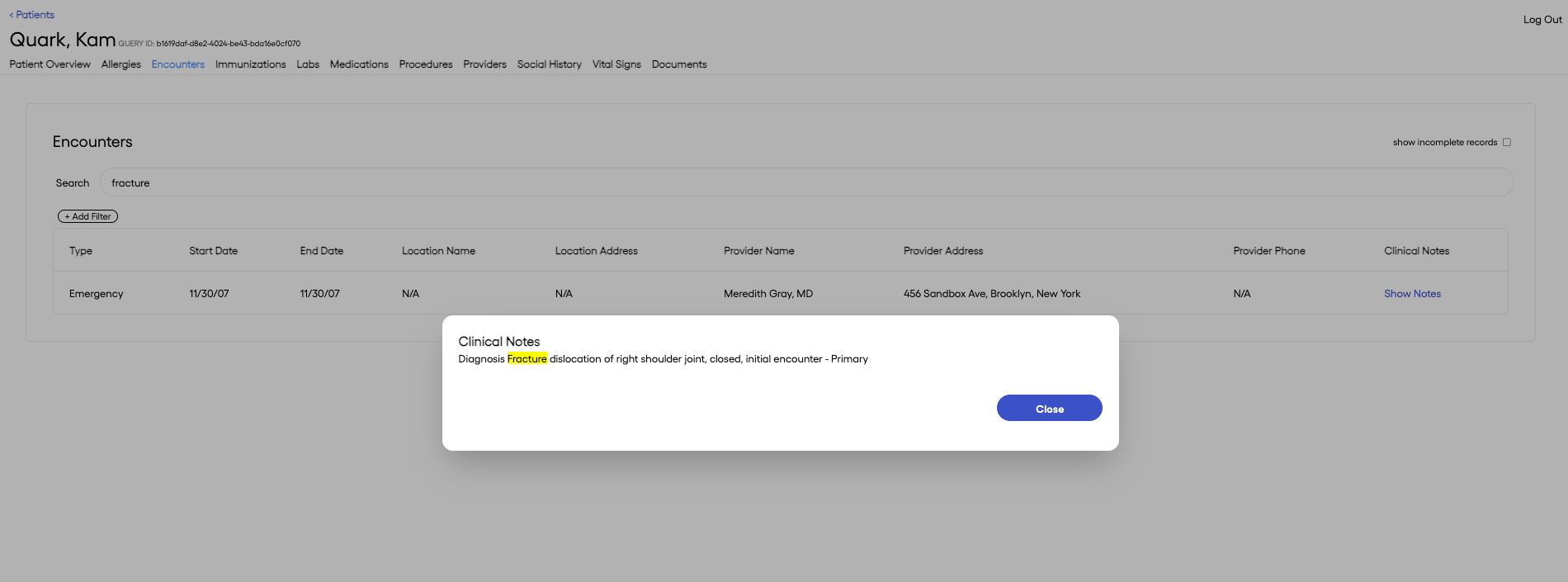
Immunizations
The immunizations page shows the patient’s immunization history, including the immunization name, dosage, and immunization date. Using the filter, you can search for specific immunizations.
Labs
Labs shows a list of all recorded labs for a patient. A user can search for a specific lab, e.g. ‘Potassium’ and see the longitudinal view of those measures. The ‘Text’ column will indicate where and when a specific lab was completed.
Use the checkbox in the upper right-hand corner to toggle seeing labs with incomplete records. By default, Particle will not show a record if any of the following data elements are missing: name, value or date, or if there are only OID values in the value field.
Medications
Medications provides a unified and deduplicated list of medications across all providers a patient has seen. Included is the medication name, code, route, dosage, prescriber, and dates associated with the medication and any given instructions.
The family class data displays the pharmaceutical family mapping, as defined by the RxNorm coding system (maintained by the National Library of Medicine) along with the generic and brand medication names (maintained by the Food and Drug Administration).
The search bar or individual filters may be used to refine the list down to specific medications and highlight various insights, e.g. the progression of medication dosages, conflicting medications, etc.
Medications are displayed in two separate views, Closed and Open medications. These separate views are intended to enable users to quickly focus on a concise list of open (active, or unknown) medications. Users can still review the historic medications, when needed.
Procedures
Procedures displays a list of recent procedures and repeated procedures. Both lists can be independently filtered by periods – All Time, Last Year, Last 90 Days, Last 60 Days, or Last 30 Days.
Procedures can be used to understand the already performed procedures that do not need to be repeated, procedures that might be due to be repeated, or repeated procedures that may or may not have been medically necessary given a patient’s state and provide a venue into understanding why those procedures were repeated.
See the associated clinical notes for each procedure by selecting ‘Show Notes’.
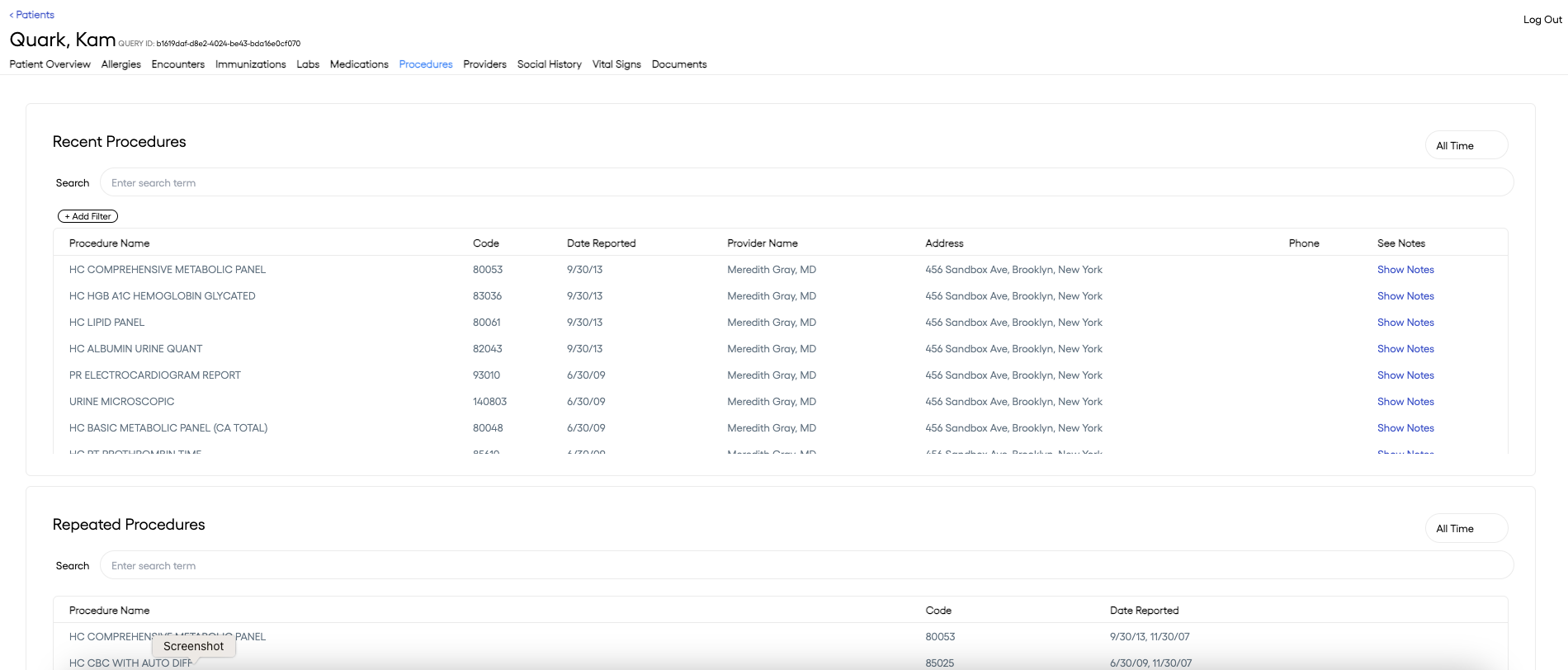
Providers
Displays all the providers that a patient has seen as part of their clinical history. Each provider’s contact information, NPI, specialty and performing role are included.
Social History
Social History highlights the patient’s social history including the observation, its value and associated code, and occurrence date.

Vital Signs
Vital Signs displays a list of all vitals recorded for a patient. The search bar enables search for specific vitals, e.g. ‘BMI’ to see a longitudinal view of that measure.

Documents
Documents gives users the ability to view source CCDA (XML) documents pulled from the HIEs, as well as other file types, including PDFs, images (JPEG, PNG), TIFF, and plain TEXT files. This will allow users to truly have all patient information to make a treatment of care decision.
CCDA documents are viewable in an easy to use CCDA viewer, enabling non-technical users to easily find pertinent information. Data from the CCDA viewer can be easily curated by domain e.g. medications, allergies, procedures, and subsequently downloaded for any needed downstream purposes. Other file types may also be downloaded given your organization's use cases.
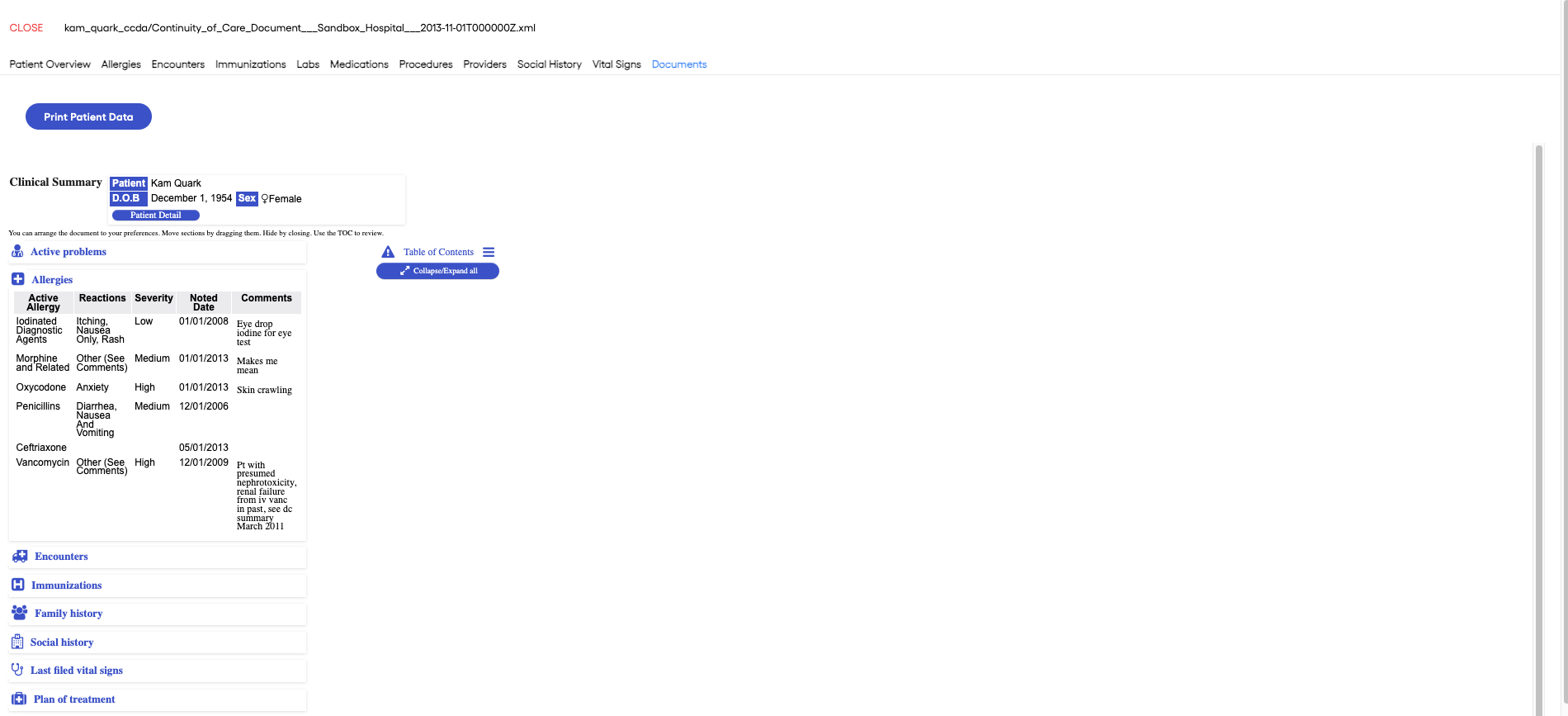
Updated 11 days ago
